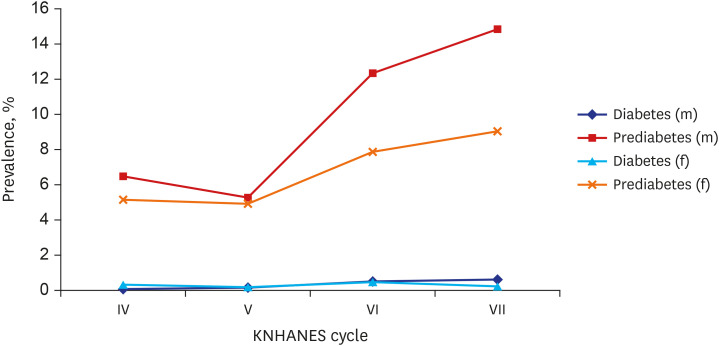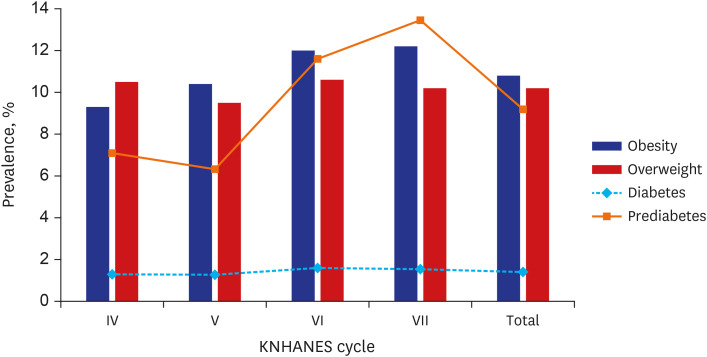Trends of Diabetes and Prediabetes Prevalence among Korean Adolescents From 2007 to 2018
- Affiliations
-
- 1Department of Pediatrics, Dongguk University Ilsan Hospital, Goyang, Korea
- 2Department of Pediatrics, Korea Cancer Center Hospital, Seoul, Korea
- KMID: 2515804
- DOI: http://doi.org/10.3346/jkms.2021.36.e112
Abstract
- Background
To provide updated prevalence data and to estimate changes in the prevalence of diabetes among Korean adolescents by sex and age between 2007 and 2018.
Methods
We used the data of children and adolescents (8,718 subjects aged 10 to 18 years) from the Korea National Health and Nutrition Examination Survey IV–VII (KNHANES 2007–2018). The recent prevalence of diabetes and pre-diabetes was estimated by using the latest KNHANES VII. The linear trends were estimated by comparing 3-year KNHANES cycles according to sex and by using logistic regression.
Results
The prevalence of diabetes and pre-diabetes was 0.298% (95% confidence interval [CI], 0.289–0.308) and 7.914% (95% CI, 0.43–0.49). The prevalence of diabetes significantly increased from 0.189 to 0.430 during KNHANE IV and VII. A positive linear trend is significant for diabetes (P trends = 0.006) in only male subjects. The prevalence of prediabetes significantly increased from 5.86 to 12.08 in both sexes. During KNHANES IV and VII, the prevalence of obesity increased significantly.
Conclusion
Between 2007 and 2018, the prevalence of diabetes among Korean adolescents increased. Further studies are required to determine the causes of these increases.
Keyword
Figure
Cited by 4 articles
-
Diagnostic and Therapeutic Strategies of Type 2 Diabetes Mellitus in Youth
Hwa Young Kim, Jae Hyun Kim
Ewha Med J. 2022;45(3):e3. doi: 10.12771/emj.2022.e3.Screening for Prediabetes and Diabetes in Korean Nonpregnant Adults: A Position Statement of the Korean Diabetes Association, 2022
Kyung Ae Lee, Dae Jung Kim, Kyungdo Han, Suk Chon, Min Kyong Moon
Diabetes Metab J. 2022;46(6):819-826. doi: 10.4093/dmj.2022.0364.2023 Clinical Practice Guidelines for Diabetes Management in Korea: Full Version Recommendation of the Korean Diabetes Association
Jun Sung Moon, Shinae Kang, Jong Han Choi, Kyung Ae Lee, Joon Ho Moon, Suk Chon, Dae Jung Kim, Hyun Jin Kim, Ji A Seo, Mee Kyoung Kim, Jeong Hyun Lim, Yoon Ju Song, Ye Seul Yang, Jae Hyeon Kim, You-Bin Lee, Junghyun Noh, Kyu Yeon Hur, Jong Suk Park, Sang Youl Rhee, Hae Jin Kim, Hyun Min Kim, Jung Hae Ko, Nam Hoon Kim, Chong Hwa Kim, Jeeyun Ahn, Tae Jung Oh, Soo-Kyung Kim, Jaehyun Kim, Eugene Han, Sang-Man Jin, Jaehyun Bae, Eonju Jeon, Ji Min Kim, Seon Mee Kang, Jung Hwan Park, Jae-Seung Yun, Bong-Soo Cha, Min Kyong Moon, Byung-Wan Lee
Diabetes Metab J. 2024;48(4):546-708. doi: 10.4093/dmj.2024.0249.Prevalence, Incidence, and Metabolic Characteristics of Young Adults with Type 2 Diabetes Mellitus in South Korea (2010–2020)
Ji Yoon Kim, Jiyoon Lee, Joon Ho Moon, Se Eun Park, Seung-Hyun Ko, Sung Hee Choi, Nam Hoon Kim
Diabetes Metab J. 2025;49(2):172-182. doi: 10.4093/dmj.2024.0826.
Reference
-
1. Chan JC, Malik V, Jia W, Kadowaki T, Yajnik CS, Yoon KH, et al. Diabetes in Asia: epidemiology, risk factors, and pathophysiology. JAMA. 2009; 301(20):2129–2140. PMID: 19470990.2. Shin JY. Trends in the prevalence and management of diabetes in Korea: 2007-2017. Epidemiol Health. 2019; 41:e2019029. PMID: 31319658.
Article3. Viner R, White B, Christie D. Type 2 diabetes in adolescents: a severe phenotype posing major clinical challenges and public health burden. Lancet. 2017; 389(10085):2252–2260. PMID: 28589895.
Article4. Rowe PA, Campbell-Thompson ML, Schatz DA, Atkinson MA. The pancreas in human type 1 diabetes. Semin Immunopathol. 2011; 33(1):29–43. PMID: 20495921.
Article5. Bacha F, Gungor N, Lee S, Arslanian SA. Progressive deterioration of β-cell function in obese youth with type 2 diabetes. Pediatr Diabetes. 2013; 14(2):106–111. PMID: 22913617.6. Dart AB, Martens PJ, Rigatto C, Brownell MD, Dean HJ, Sellers EA. Earlier onset of complications in youth with type 2 diabetes. Diabetes Care. 2014; 37(2):436–443. PMID: 24130346.
Article7. Dart AB, Sellers EA, Martens PJ, Rigatto C, Brownell MD, Dean HJ. High burden of kidney disease in youth-onset type 2 diabetes. Diabetes Care. 2012; 35(6):1265–1271. PMID: 22432116.
Article8. Constantino MI, Molyneaux L, Limacher-Gisler F, Al-Saeed A, Luo C, Wu T, et al. Long-term complications and mortality in young-onset diabetes: type 2 diabetes is more hazardous and lethal than type 1 diabetes. Diabetes Care. 2013; 36(12):3863–3869. PMID: 23846814.
Article9. Gourgari E, Stafford JM, D'Agostino R Jr, Dolan LM, Lawrence JM, Marcovina S, et al. The association of low-density lipoprotein cholesterol with elevated arterial stiffness in adolescents and young adults with type 1 and type 2 diabetes: the SEARCH for Diabetes in Youth Study. Pediatr Diabetes. 2020; 21(5):863–870. PMID: 32304144.10. Koebnick C, Imperatore G, Jensen ET, Stafford JM, Shah AS, Mottl AK, et al. Progression to hypertension in youth and young adults with type 1 or type 2 diabetes: the SEARCH for Diabetes in Youth Study. J Clin Hypertens (Greenwich). 2020; 22(5):888–896. PMID: 32297456.
Article11. Magliano DJ, Sacre JW, Harding JL, Gregg EW, Zimmet PZ, Shaw JE. Young-onset type 2 diabetes mellitus - implications for morbidity and mortality. Nat Rev Endocrinol. 2020; 16(6):321–331. PMID: 32203408.
Article12. Hannon TS, Arslanian SA. The changing face of diabetes in youth: lessons learned from studies of type 2 diabetes. Ann N Y Acad Sci. 2015; 1353(1):113–137. PMID: 26448515.
Article13. Daniels SR. The consequences of childhood overweight and obesity. Future Child. 2006; 16(1):47–67. PMID: 16532658.
Article14. Williams DE, Cadwell BL, Cheng YJ, Cowie CC, Gregg EW, Geiss LS, et al. Prevalence of impaired fasting glucose and its relationship with cardiovascular disease risk factors in US adolescents, 1999-2000. Pediatrics. 2005; 116(5):1122–1126. PMID: 16263998.
Article15. Kweon S, Kim Y, Jang MJ, Kim Y, Kim K, Choi S, et al. Data resource profile: the Korea National Health and Nutrition Examination Survey (KNHANES). Int J Epidemiol. 2014; 43(1):69–77. PMID: 24585853.
Article16. Kim JH, Yun S, Hwang SS, Shim JO, Chae HW, Lee YJ, et al. The 2017 Korean National Growth Charts for children and adolescents: development, improvement, and prospects. Korean J Pediatr. 2018; 61(5):135–149. PMID: 29853938.
Article17. Brown LD, Cai TT, DasGupta A. Interval estimation for a binomial proportion. Stat Sci. 2001; 16(2):101–133.
Article18. Menke A, Casagrande S, Cowie CC. Prevalence of diabetes in adolescents aged 12 to 19 years in the United States, 2005-2014. JAMA. 2016; 316(3):344–345. PMID: 27434447.
Article19. Dabelea D, Mayer-Davis EJ, Saydah S, Imperatore G, Linder B, Divers J, et al. Prevalence of type 1 and type 2 diabetes among children and adolescents from 2001 to 2009. JAMA. 2014; 311(17):1778–1786. PMID: 24794371.
Article20. Candler TP, Mahmoud O, Lynn RM, Majbar AA, Barrett TG, Shield JP. Continuing rise of type 2 diabetes incidence in children and young people in the UK. Diabet Med. 2018; 35(6):737–744. PMID: 29460341.
Article21. Urakami T. Screening of childhood type 2 diabetes in Japan. Diabetes Res Clin Pract. 2016; 120:S8.
Article22. Wang Z, Zou Z, Wang H, Jing J, Luo J, Zhang X, et al. Prevalence and risk factors of impaired fasting glucose and diabetes among Chinese children and adolescents: a national observational study. Br J Nutr. 2018; 120(7):813–819. PMID: 30153872.
Article23. Fu JF, Liang L, Gong CX, Xiong F, Luo FH, Liu GL, et al. Status and trends of diabetes in Chinese children: analysis of data from 14 medical centers. World J Pediatr. 2013; 9(2):127–134. PMID: 23677831.
Article24. DIAMOND Project Group. Incidence and trends of childhood type 1 diabetes worldwide 1990-1999. Diabet Med. 2006; 23(8):857–866. PMID: 16911623.25. Song SO, Song YD, Nam JY, Park KH, Yoon JH, Son KM, et al. Epidemiology of type 1 diabetes mellitus in Korea through an investigation of the national registration project of type 1 diabetes for the reimbursement of glucometer strips with additional analyses using claims data. Diabetes Metab J. 2016; 40(1):35–45. PMID: 26912154.
Article26. Yabe D, Seino Y, Fukushima M, Seino S. β cell dysfunction versus insulin resistance in the pathogenesis of type 2 diabetes in East Asians. Curr Diab Rep. 2015; 15(6):602. PMID: 25944304.
Article27. Ha KH, Kim DJ. Trends in the diabetes epidemic in Korea. Endocrinol Metab (Seoul). 2015; 30(2):142–146. PMID: 26194073.
Article28. Rhee EJ. Diabetes in Asians. Endocrinol Metab (Seoul). 2015; 30(3):263–269. PMID: 26435131.
Article29. Smyth S, Heron A. Diabetes and obesity: the twin epidemics. Nat Med. 2006; 12(1):75–80. PMID: 16397575.
Article30. American Diabetes Association. Type 2 diabetes in children and adolescents. Pediatrics. 2000; 105(3 Pt 1):671–680. PMID: 10699131.31. Khang AR. Letter: Clinical characteristics of people with newly diagnosed type 2 diabetes between 2015 and 2016: difference by age and body mass index (Diabetes Metab J 2018;42:137-46). Diabetes Metab J. 2018; 42(3):249–250. PMID: 29938403.
Article32. Lim JS, Kim EY, Kim JH, Yoo JH, Yi KH, Chae HW, et al. 2017 Clinical practice guidelines for dyslipidemia of Korean children and adolescents. Ann Pediatr Endocrinol Metab. 2020; 25(4):199–207. PMID: 33401878.
Article
- Full Text Links
- Actions
-
Cited
- CITED
-
- Close
- Share
- Similar articles
-
- Trends and Risk Factors of Metabolic Syndrome among Korean Adolescents, 2007 to 2018 (Diabetes Metab J 2021;45:880-9)
- Trends and Risk Factors of Metabolic Syndrome among Korean Adolescents, 2007 to 2018
- Trends in prediabetes and diabetes prevalence and associated risk factors in Vietnamese adults
- Trends and Risk Factors of Metabolic Syndrome among Korean Adolescents, 2007 to 2018 (Diabetes Metab J 2021;45:880-9)
- Sex differences in factors associated with prediabetes in Korean adults



